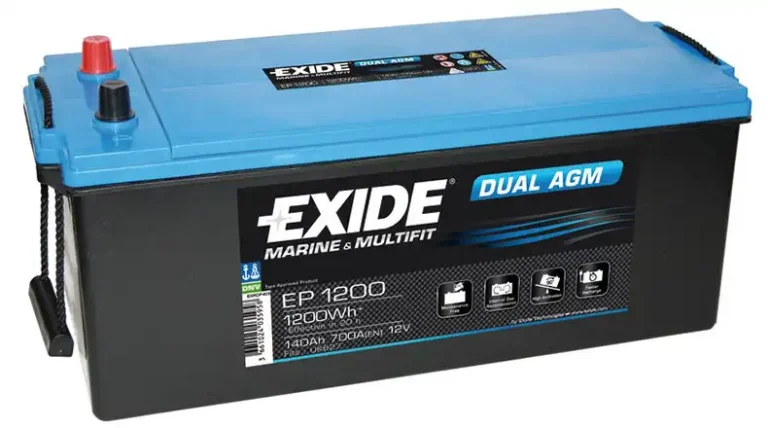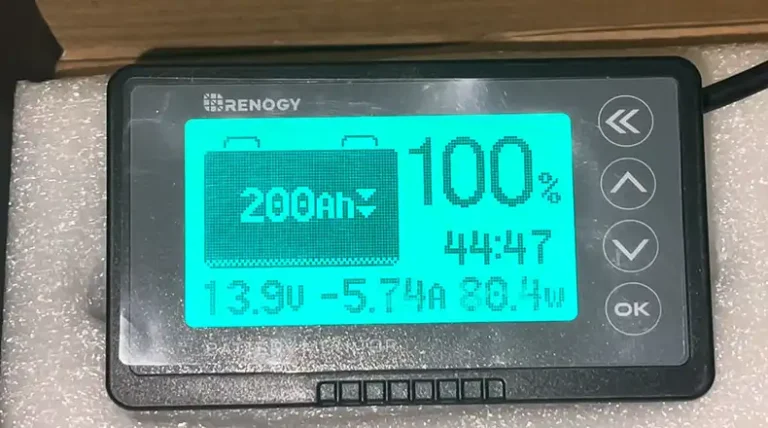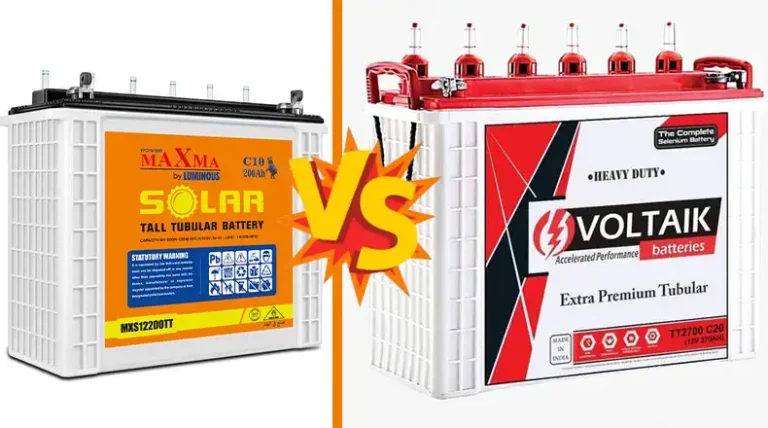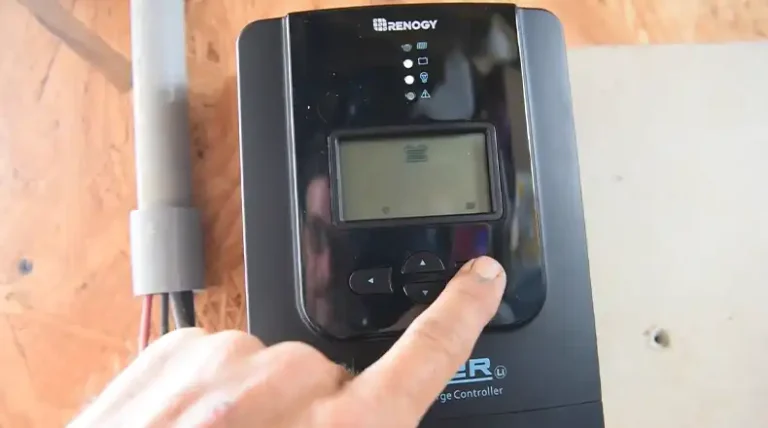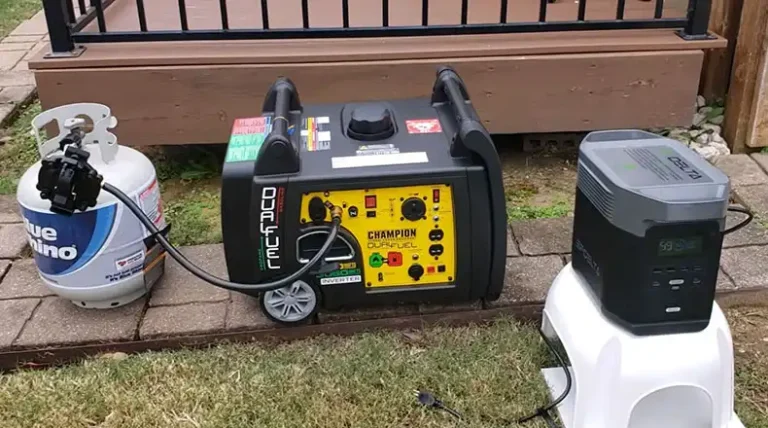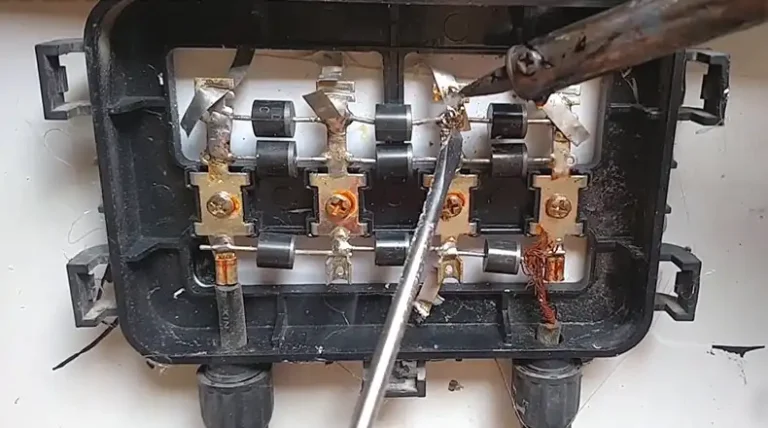Difference Between Solar and Inverter Battery
One of the challenges with solar power is the intermittent nature of its generation. This is where energy storage solutions, such as solar and inverter batteries, come into play. These batteries serve different purposes and have distinct characteristics that set them apart.
In this article, we’ll explore the differences between solar and inverter batteries, their core functionalities, technical specifications, applications, cost considerations, maintenance requirements, environmental impact, and their respective pros and cons.
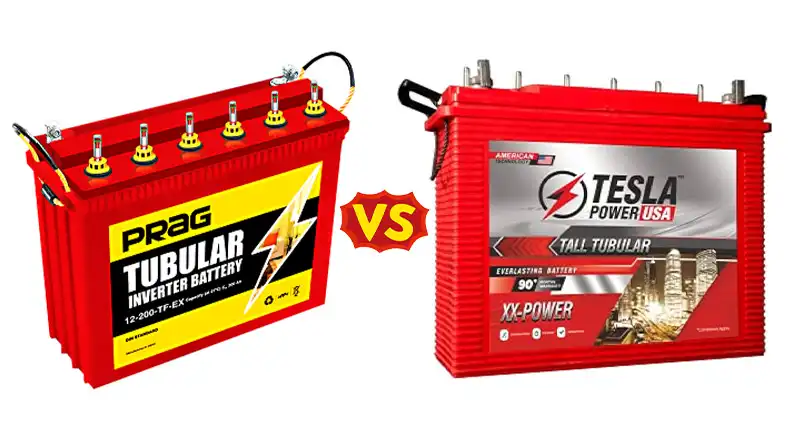
What Are the Differences Between Solar and Inverter Battery?
While both solar and inverter batteries are essential components in energy storage systems, they differ in their primary purposes, charging sources, and technical specifications. Understanding these differences is crucial for selecting the appropriate battery type for your specific energy needs.
Difference Table
Here’s a quick overview of the key differences between solar and inverter batteries –
| Aspect | Solar Battery | Inverter Battery |
| Primary Purpose | Store excess solar energy | Provide backup power |
| Charging Source | Solar panels | Utility grid or dedicated charger |
| Battery Chemistry | Lithium-ion or Flow batteries | Lead-acid (Flooded or AGM) |
| Discharge Rates | Frequent cycling (daily) | Not optimized for frequent cycling |
| Capacity and DoD | Higher capacity, deeper DoD | Lower capacity, shallower DoD |
| Typical Applications | Grid-tie solar, Off-grid solar | Grid-connected backup power |
| Cost | Generally more expensive | Generally less expensive |
| Maintenance | Minimal maintenance | Periodic maintenance required |
| Environmental Impact | Potential for recycling | Proper disposal required |
Core Functionality
The core functionality of solar and inverter batteries lies in their distinct purposes and charging sources.
Solar Battery:
- Stores excess solar energy generated during the day for later use, primarily at night or during periods of low solar production.
- Directly charged by the solar panels installed in the solar energy system.
Inverter Battery:
- Provides backup power to essential appliances and circuits during grid outages or power disruptions.
- Typically charged by the utility grid when power is available, or through a dedicated charger connected to the grid.
Technical Specifications
To understand the differences between solar and inverter batteries more comprehensively, let’s delve into their technical specifications.
Battery Chemistry
Solar batteries commonly use lithium-ion (Li-ion) or flow batteries. Li-ion batteries offer high energy density and long lifespans, while flow batteries have an even longer lifespan and can handle deeper discharge cycles.
Inverter Batteries typically use lead-acid batteries, either flooded or absorbed glass mat (AGM) types. Lead-acid batteries are generally less expensive but have a shorter lifespan compared to lithium-ion batteries.
Discharge Rates
Solar batteries are designed to handle frequent cycling, meaning they can be charged and discharged on a daily basis without significant degradation.
Typical discharge rates for lithium-ion solar batteries range from 0.2C to 1C, where C represents the battery’s rated capacity.
Flow batteries sustain discharge rates typically ranging from 1C to 4C, making them suitable for applications that require high power output.
On the other hand, inverter batteries, particularly lead-acid batteries, are not optimized for frequent cycling and have a limited depth of discharge to prolong their lifespan.
Lead-acid batteries used in inverter applications typically have a discharge rate of around 0.05C to 0.2C, which means they can deliver their rated capacity over a period of 5 to 20 hours.
Capacity and Depth of Discharge (DoD)
Solar Batteries typically have capacities ranging from 5 kWh to 40 kWh for residential systems, and up to several hundred kWh for larger commercial or utility-scale installations.
They can be discharged to a depth of 80% to 100% of their rated capacity without significant degradation, providing a higher amount of usable energy storage.
Inverter batteries commonly used in backup power applications have capacities ranging from 2 kWh to 20 kWh for residential systems.
These batteries have a shallower depth of discharge, typically ranging from 30% to 50% of their rated capacity, to prolong their lifespan.
Application and Use Cases
The applications and use cases of solar and inverter batteries are closely tied to their respective purposes.
Solar Battery:
- In grid-tied solar systems, solar batteries store excess energy generated during the day for use at night or during power outages, providing backup power.
- In off-grid solar systems, solar batteries are essential for storing energy and providing a reliable power supply when the sun is not shining.
Inverter Battery:
- Inverter batteries are commonly used in grid-connected homes to provide backup power to essential appliances and circuits during power outages, ensuring uninterrupted operation.
Cost Considerations
The cost of solar and inverter batteries can vary significantly, with solar batteries generally being more expensive than inverter batteries. Several factors influence the overall cost, including –
Battery Chemistry: Lithium-ion batteries used in solar applications tend to be more expensive than lead-acid batteries used in inverter applications.
Capacity: Higher-capacity batteries, necessary for larger energy storage requirements, typically come at a higher cost.
Brand and Quality: Reputable brands and higher-quality batteries often command a premium price.
Here are some typical cost ranges –
Solar Battery:
- Lithium-ion solar batteries can cost between $500 and $1,200 per kWh of capacity, depending on the brand, quality, and chemistry.
- Flow batteries used in larger solar installations can cost between $800 and $1,500 per kWh of capacity.
Inverter Battery:
- Lead-acid inverter batteries are generally less expensive, ranging from $150 to $400 per kWh of capacity.
Maintenance and Lifespan
Proper maintenance and lifespan considerations are crucial for ensuring the optimal performance and longevity of both solar and inverter batteries.
Solar Battery:
- Solar batteries, particularly lithium-ion batteries, require minimal maintenance beyond monitoring the system’s performance and ensuring proper ventilation and temperature control.
- The lifespan of solar batteries can range from 5 to 15 years, depending on usage patterns, quality, and operating conditions. Higher-end lithium-ion and flow batteries tend to have longer lifespans.
Inverter Battery:
- Lead-acid batteries used in inverter applications may require periodic maintenance, such as checking and replenishing electrolyte levels (for flooded batteries) and ensuring proper ventilation.
- Inverter batteries typically have a shorter lifespan compared to solar batteries, ranging from 3 to 5 years, depending on usage patterns and maintenance practices.
Environmental Impact
As sustainability becomes an increasingly important consideration, it’s essential to evaluate the environmental impact of solar and inverter batteries.
Solar Battery:
- Lithium-ion batteries used in solar applications have the potential for responsible recycling, where valuable materials like lithium, cobalt, and nickel can be recovered and reused, reducing environmental impact.
Inverter Battery:
- Lead-acid batteries used in inverter applications contain lead, which is a toxic substance. Proper disposal and recycling of these batteries are crucial to minimize environmental contamination and potential health risks.
Pros and Cons
To help you make an informed decision, let’s explore the pros and cons of solar and inverter batteries.
Solar Battery:
Pros
- Higher energy storage capacity and deeper discharge cycles
- Designed for frequent charging and discharging cycles
- Longer lifespan and lower maintenance requirements
- Potential for responsible recycling
Cons
- Generally more expensive upfront cost
- May require a larger initial investment in solar panels and other components
Inverter Battery:
Pros
- Lower upfront cost compared to solar batteries
- Suitable for backup power applications during grid outages
- Well-established technology with widely available replacement options
Cons
- Lower energy storage capacity and shallower discharge cycles
- Not optimized for frequent charging and discharging cycles
- Shorter lifespan and potential maintenance requirements
- Proper disposal required due to lead content
Wrapping It Up
When it comes to energy storage solutions, both solar and inverter batteries play crucial roles in ensuring a reliable and sustainable power supply. Solar batteries are designed to store excess solar energy for later use, enabling homeowners and businesses to maximize their solar investment and achieve greater energy independence. On the other hand, inverter batteries serve as a backup power source during grid outages, providing peace of mind and uninterrupted operation for essential appliances and circuits.
Frequently Asked Questions
Can I use both solar and inverter batteries in the same system?
Yes, it is possible to integrate both solar and inverter batteries in the same energy storage system. This hybrid approach can provide the benefits of both technologies, allowing you to store excess solar energy for later use while also having a dedicated backup power source during grid outages.
How do I determine the appropriate battery capacity for my needs?
Determining the appropriate battery capacity involves considering several factors, such as your daily energy consumption, desired backup duration, and potential future energy needs. A professional energy consultant or solar installer can assist you in calculating the required battery capacity.
Can I expand my battery storage capacity in the future?
Yes, many solar and inverter battery systems are designed to be modular and scalable, allowing you to add additional battery capacity as your energy needs grow. This flexibility ensures that your energy storage system can adapt to your changing requirements over time, reducing the need for a complete system replacement.

